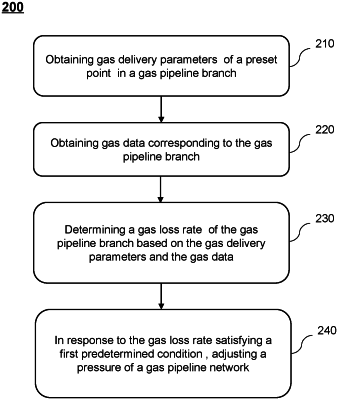| CPC F17D 5/005 (2013.01) [G16Y 10/35 (2020.01); G16Y 20/30 (2020.01); G16Y 40/10 (2020.01); G16Y 40/35 (2020.01)] | 4 Claims |

|
1. A method for gas loss control based on a smart gas platform executed by a smart gas device management platform of an Internet of Things (IoT) system for gas loss control based on a smart gas platform, comprising:
obtaining gas delivery parameters of a preset point in a gas pipeline branch, wherein the gas delivery parameters include a pressure, a temperature, and a gas flow rate of gas delivery;
obtaining gas data corresponding to the gas pipeline branch;
determining a gas loss rate of the gas pipeline branch based on the gas delivery parameters and the gas data, wherein the gas data is obtained based on readings of a gas metering device, the gas data includes at least a total amount of gas supply and a total amount of gas consumption; and
determining the gas loss rate of the gas pipeline branch includes:
determining an estimated gas loss rate of the gas pipeline branch based on the total amount of gas supply and the total amount of gas consumption;
determining a confidence level of the estimated gas loss rate by a first prediction model based on metering device data and the gas delivery parameters, the first prediction model being a machine learning model; and
constructing a sequence of confidence levels based on the confidence level;
constructing a to-be-matched vector based on the sequence of confidence levels, searching in a database based on the to-be-matched vector, determining a history vector that meets a matching condition as a target vector; and
determining a reference gas loss rate corresponding to the target vector as the gas loss rate;
in response to the gas loss rate satisfying a first predetermined condition, generating at least one candidate operating parameter;
predicting a predicted loss rate corresponding to each of the at least one candidate operating parameter based on a second prediction model, wherein the second prediction model is a machine learning model;
determining a target operating parameter based on a candidate operating parameter with a predicted loss rate satisfying a second predetermined condition in the at least one candidate operating parameter; and
adjusting a pressure of a gas pipeline network based on the target operating parameter.
|